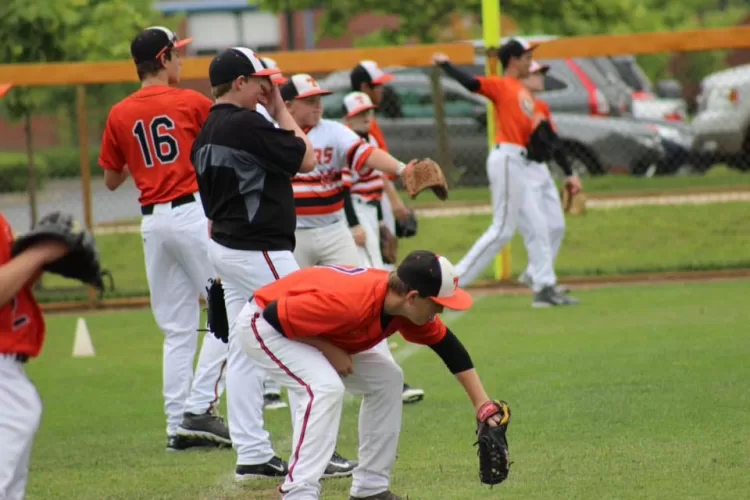I’ve seen firsthand just how important proper warm-ups are before any throwing session. Whether it’s a pre-game warmup, a bullpen session, or even just playing catch – taking the time to properly get the body ready can make all the difference in performance and injury prevention.
Proper warm-ups before throwing sessions are crucial because they activate muscles, increase blood flow, raise core body temperature, enhance range of motion, and help prevent injuries.
Warming Up The Shoulder in Baseball
The shoulder is the most important joint for a baseball player. As the main connector between the torso and throwing arm, the shoulder bears the brunt of the stress from throwing. That’s why properly warming up the shoulder is so vital.
When warming up the shoulder, you want to focus on light, multi-directional movements to activate the rotator cuff and scapular muscles. Front arm raises, bent-over rear flys, and shoulder circles are great options. Use little to no weight and focus on controlled motions for 15-20 reps. This activates the muscles, increases blood flow, and lubricates the shoulder joint.
Proper shoulder warm-ups will enhance range of motion and elasticity before throwing. This allows you to achieve full arm rotation and extension when throwing without over-stressing the joint. Numerous studies have shown that comprehensive shoulder warm-ups can reduce injury risk by up to 30% in overhead athletes. Take the time to slowly and methodically warm-up the shoulder before throwing. Your arm will thank you!
Warming Up The Elbows For Baseball
While the shoulder gets most of the attention, the elbow also plays a huge role during throwing. Serving as the hinge point where massive forces are generated, the elbow can be vulnerable without proper preparation.
When warming up the elbow, focus on flexing, extending, pronating, and supinating the joint through full ranges of motion. This means doing full wrist curls, tricep extensions, and forearm rotations to activate all the musculature and lubricate the joint spaces. Use little weight and do 12-15 controlled reps of each motion.
You also want to do full-motion elbow circles and extension holds with a band to prep the joint tissues and ligaments before throwing. The elasticity from dynamic warm-ups enhances the elbow’s ability to safely achieve max velocities during a pitch without excessive strain. Make sure to get the blood flowing to the elbow before picking up a ball!
Warming Up The Wrists and Hands
Being the final points where force is applied to the ball, the wrist and hand are vital to proper throwing mechanics. These delicate joints need to be fully prepped before throwing to operate properly.
Start by doing full wrist circles in both directions to limber up the joint. Next, flex and extend the wrist fully while using your other hand to provide slight tension. This activates the muscles and connective tissues that control the wrist joint.
For the hand, alternate between making a tight fist and fully extending the fingers. Do finger and thumb isolation exercises like playing the piano to prep each digit. Grip strength trains with light tension are also useful. This full hand and wrist warmup enhances dexterity and strength before throwing. Don’t overlook these small but important joints!
The Core and Lower Body
While the upper body gets most of the glory, throwing actually originates in the legs and core. Generating power begins with the firm ground contact of the legs, travels upward through rotational force of hips and core, continues through the kinetic chain to the shoulder, and finally is released by the arm and hand.
That’s why properly warming up the lower body and core is integral to throwing success. Leg swings, squats, lunges, and balance exercises activate the legs before throwing. Core twists, rotations, and planks fire up the midsection. Enhanced mobility and blood flow to these areas helps translate their power upwards for maximum velocity.
A comprehensive lower body and core warmup also prevents injuries during throwing. The rotational and eccentric forces experienced can strain muscles, tendons, and ligaments in the legs and midsection. Dynamic warmups enhance the elasticity and reactive ability of these areas to withstand throwing forces safely. Leave no area unprepared!
The Mind and Nervous System
While physical warmup is essential, we can’t overlook the importance of mental preparation as well. Throwing a baseball requires intense hand-eye coordination, muscle memory, and cognitive focus. To excel at throwing, you need your mind and nervous system warmed up and ready as much as your body.
That’s why structured mental warmups are a key part of pre-throw routines. Visualization, mental rehearsal, and pitch sequencing drills activate neural pathways and enhance mental acuity before throwing. Staying relaxed through deep breathing also helps regulate the nervous system for optimal throwing.
You can think of mental warmups like getting your mind “into the zone” for throwing. Just like your muscles, your mind and nervous system need activation and preparation for peak performance. Make mental readiness an equal component of your pre-throw routine.
Aerobic Warm-Ups for Baseball
An aerobic warmup is the glue that ties the whole routine together. Some light cardiovascular activity raises your core body temperature, increases overall blood flow, and enhances tissue elasticity throughout the body. It quite literally warms you up!
For throwing sessions, light jogging or biking for 5-10 minutes is perfect. Focus on increasing your breathing and heart rate rather than high intensities. This primes your body’s physiological systems for the dynamic efforts required during throwing through raised core temperature and circulation.
Finish your aerobic warmup by incorporating the dynamic movements mentioned earlier. Arm swings, torso twists, leg kickbacks, squats, and lunges continue elevating your heart rate while also activating key muscle groups for throwing. Time your dynamic movements so you complete them just as your core temperature peaks for maximum benefit. A proper aerobic warmup is the foundation for an effective pre-throw routine.
Recovery Between Reps
While getting warmed up is critical, what you do between warmup sets and maximal throwing efforts is just as important. Always be sure to rest and recover adequately between warmup reps and intense throwing.
During your warmup sets, rest 30-60 seconds between lighter throw sets to allow muscles time to recover. Then, be sure to rest 3-5 minutes after your final warmup sets before maximal velocity efforts. This allows your activated muscles to fully normalize before intense throws.
Shifting immediately from warmups to max intensity throwing can spike injury risk due to muscular fatigue. Proper rest between warmups and intense throwing also allows your mind to reset and refocus before executing at 100%. Don’t rush the process by skipping rest periods. Let your body and mind recover properly between warmup and throwing.
The Effectiveness of Dynamic Warm-Ups In Baseball
Utilizing dynamic warmups before throwing is proven to optimize performance and reduce injuries versus static stretching alone. Dynamic movements enhance tissue temperature, elasticity, mobility, and neurological activation compared to simply stretching muscles passively.
In a study of college baseball pitchers, those who warmed up dynamically had faster pitch velocities and lower reports of arm soreness than those who only did static stretching. Proper dynamic warmups quite literally “prime” your body for explosive power needed during throwing motions.
Don’t passively stretch tight muscles and expect it to be enough. Actively take your body through regimented, multi-planar movements before throwing to unlock your performance potential and provide injury protection. Embrace dynamic warmups.
The Power of Pre-Throw Routines
All the warmup elements covered should be incorporated into a structured pre-throw routine you execute each time before throwing. Pre-throw routines promote proper preparation on both physical and mental levels.
Having a planned sequence of progressive warmups establishes a rhythmic throwing rhythm. Starting aerobically, then gradually increasing intensity activates muscles systematically without strain. Regulated rest periods also allow muscles, joints, and the mind to recover between efforts.
Over time, ingrained pre-throw routines become automatic for your body and mind. This enhances throwing consistency and focus. Pre-throw routines also ensure you fully prepare every time rather than rushing preparation and risking injury when you’re in a hurry.
Treat warmups seriously by crafting and sticking to pre-throw routines. Not only will it prime your body for peak throwing performance, it will extend your playing career and long-term arm health. Be disciplined to reap the rewards.
Common Warm-Up Mistakes to Avoid
While comprehensive warmups are clearly vital, many mistakes are also frequently made:
- Insufficient shoulder warmup – The shoulder bears the brunt of throwing forces and commonly succumbs to overuse injuries when inadequately prepped. Don’t overlook shoulder warmups.
- Warming up too quickly – Progressively building intensity allows muscles to adapt to increasing demands. Rushing through warmup sets spikes injury risk.
- Too much static stretching – Light stretching is fine, but relying on it excessively can diminish power and lead to strains. Use dynamic movements instead.
- Not enough warmup recovery time – Muscles repair and strengthen during rest phases. Make sure to adequately recover between warmup sets.
- Skipping the mental warmup – Throwing requires intense focus. Prime your mind through visualization, rehearsal, and relaxation before throwing.
- No set pre-throw routine – Structure promotes throwing rhythm and removes preparation variables that lead to inconsistency and heightened injury potential. Follow a set routine.
Consistently avoiding these all-too-common missteps will enhance performance, consistency, and longevity across a throwing career.
In Closing
As someone who’s spent decades in the game as a player and coach, I cannot overstate just how vital proper, progressive warmups are before throwing a baseball. Not only will they provide an immediate performance boost compared to an insufficient warmup, but they will extend your playing career and long-term health which every athlete values greatly. Treat your warmup as an essential element embedded into every throwing session you do rather than a trivial formality. Your body will reward you in the short-term with enhanced velocity and command. Over the long-haul, you’ll have the arm longevity to enjoy the game for a lifetime. So take the extra time to adequately prepare, make it a habit through regimented pre-throw routines, and reap the considerable benefits proper warmups provide. Your arm will thank you!
Frequently Asked Questions
How long should a complete pre-throw warmup routine take?
A proper progressive warmup routine should take 20-30 minutes including aerobic warmup, dynamic movements, static stretching, practice throws at increasing intensities, and adequate rest between sets. The length allows muscles, joints, and the mind to be activated without rushing the process.
Are heavy weighted warmup exercises helpful or harmful?
Leave any heavy weights out of your pre-throw warmup, especially for the arm and shoulder. The goal is controlled, multi-planar movements to enhance mobility, blood flow, and tissue elasticity – not muscle fatigue. Keep any resistance light and focus on form.
How many warmup sets are ideal before maximal throwing?
Most experts recommend 3-5 graduated throwing sets after your dynamic warmup ranging from 30% intensity up to 80% maximum effort with full recovery between sets. This safely bridges the gap from warmup to peak exertion.
Is warming up equally important before pitching versus playing catch?
Yes, a disciplined and progressive warmup routine is recommended before any type of throwing session from pitching in a game to casual long toss. Throwing a baseball is an unnatural motion requiring total body coordination and various tissues being primed for safety.
If I’m pressed for time, which warmup elements are most crucial?
If limited on time, prioritize shoulder mobility, an aerobic warmup, tissue elasticity through dynamic movements, and at least 3-4 ramped up practice sets before throwing at max effort. These prime your body most efficiently within a compressed timeframe.


